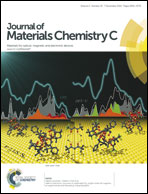UV-induced improvement in ZnO thin film conductivity: a new in situ approach†
Abstract
We report a long-lasting enhancement in electrical properties occurs when zinc oxide (ZnO) thin films prepared by spray pyrolysis in a nitrogen atmosphere are treated with UV prior to the films' first exposure to air (here termed “in situ irradiation”). Carrier mobilities as high as 44.3 cm2 V−1 s−1 – the highest values yet reported for any ZnO thin films made by spray pyrolysis – are exhibited by samples deposited at ca. 376 °C. In fact, such mobility values compare favorably with results that have been obtained using more complex, vacuum-based deposition techniques. The results of electrical, chemical, and microstructural characterization as a function of irradiation and deposition temperature indicate that the improved electrical properties stem from a modification of the relative populations of donor and acceptor defects at the grain boundaries of these polycrystalline films, allowing parallels to be drawn to the well-known phenomenon of “persistent” photoconductivity in ZnO. Finally, we consider how these observations about the interaction of ZnO with UV light relate to factors that limit the electrical performance of practical, transparent conducing oxide thin films.


 Please wait while we load your content...
Please wait while we load your content...